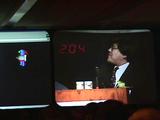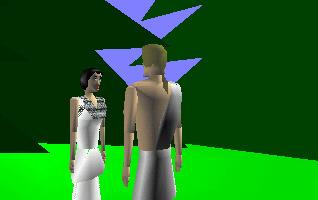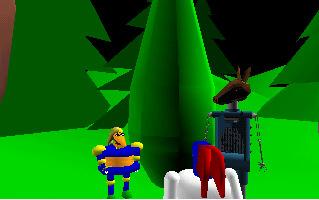
Dateline: 9/30/98
VRML Dream - A Vision Pulls a Community
Note: most of this is actually an article intended for a print magazine, apparently having financial problems so y'all get it here :-) I've added links to various places throughout for this on-line version.
VRML Dream is a project imagined by Stephen Matsuba and Bernie Roehl. The idea behind VRML Dream is to bring a "live" distributed performance of the play A Midsummer Night’s Dream by Shakespeare, to your desktop. Much of the information for this article was generously provided by Stephen and Bernie via on-line interviews, and they have my sincere thanks.
Timing
VRML Dream started originally around June of 1997 with some early
discussions between Stephen and Bernie. Activity didn’t start in earnest
until Sept. 97. The original driving date and goals were set for a performance
or early demos for VRML 98 which was in mid Feb. 98.
The VRML Dream Company (as it is now known) is offering up a replay
of a (URL gone) portion of the performance...it's real streaming VRML and well worth
checking out.
The original plan’s milestones were to 1) finish the models, 2) showcase the technology at VRML98, 3) have the performance on April 23 were clearly ambitious. Yet, one of the compelling aspects of the project, was the audacity of the technical ambition of the goals. In the early June discussions, Stephen and Bernie dreamed (pun intended) up the notion of a live streamed VRML performance over the Web.
In reality there was no performance for VRML98, however many of the models and the "virtual" sets were fairly complete. Some were shown as part of the VRML98 Demo Night.
Figure 1: Stephen Matsuba showing some of the models of VRML Dream at VRML 98
Figure 2: Bernie Roehl at VRML 98 in the HANIM working group meeting showing some of the VRML Dream models.
During late night hacking sessions in a hotel room some of the models were integrated into scenes for the first time. It was also the first time many of the people working on the Dream got a sense of the look of the whole project.
Figure 3: In hotel room at VRML 98. From front to back J. Eric Mason, Stephen Matsuba, Cindy Reed-Ballreich, Bernie Roehl, Dennis McKenzie (on right not at table).
Figure 4: In hotel room at VRML 98, Cindy hacking away, with Bernie at her right.
Communities
As VRML Dream gained in momentum, mostly from news seeping in to the VRML mailing list a group of volunteers coalesced. According to Stephen Matsuba, three distinct communities developed, the modelers, the programmers and the music people. The modelers were Dennis McKenzie, John Nikkel, Andrew Reitemeyer and J. Eric Mason. At a later state of the project Stashia McGehee created Puck but wasn’t part of the main group.
The programmers group was mostly Bernie with Justin Couch consulting of some issues. Charlie Lindahl and Mike Fleming also contributed some pieces. The music group consisted of Len Bullard, Bob Crispen and Lance Ong. Finally Stephen’s role "…was more of the Überwatcher. I made sure that the different components were in place at the right times."
Each group developed a leader of sorts. Again according to Stephen, "The modelers had Dennis, the programmers had Bernie, and the musicians had Len." The dynamics of the groups evolved in an interesting way. Dennis was "A quiet leader who earned the respect of the other modelers by the quality of his work, and the strength of his direction." Len was a, "take charge kind of guy" and got things going but in the end was also responsible for getting most of the music material out. Bernie basically plugged away at everything and asked for help when needed. Stephen’s role was essentially the producer, acting as the conduit "that connected all these elements together and to make sure that they were in step with each other."
Development Issues
Obviously the technical issues to carry out VRML Dream are immense. All of the problems, as of the writing of this article, have still not been conquered. Streaming of the motion of the characters was solved by the performance date, but the big problem then was the sound. During testing the streamed sound worked fine, but for the actual performance it didn’t work. With more than a few people listening at the same time, the Speak Freely program used for the audio was unable to handle the multicasting. Proprietary streaming audio solutions exist, such as Real Audio, but there is still an unresolved issue of synchronizing the action with the sound. In addition a proprietary solution is not what the VRML community desires for a workable solution to an open international standard.
Aside from the streaming issues the other big problem was to keep the size of the VRML world small enough to allow the VRML browser to perform at an acceptable frame rate. The goal was to keep the size of all files, midi sound, VRML and textures, down to under 200K and a frame rate of not less than 5fps. As one who lives on large workstations with dedicated network connections this is an amazing goal. In fact, this goal was met with the VRML totaling under 100K and the rest totaled about 80K for a grand total of 180K. The reason for placing everything in one file was to ensure that when model had to be switched in that would occur instantly with no delays such as those that occur with inlines.
Performance Day
The actual performance was pushed back to a Sunday to reduce problems with traffic on the net. So on Sunday April 26, VRML Dream went live. The performance was scheduled to start at 12 noon eastern time and after about an hour of delay it started. The scene appeared and was very dark so I thought uh oh, then the lights turned on and the Temple was well lit and I though, "hey it’s just like a real play!" The lack of sound was frustrating for all but the motions worked quite well and the characters and scenes changes quite smoothly. During the entire performance we also opened up an IRC chat. The chat turned out that it was invaluable to be able to ask people, especially before it started and during the intermission, what was going on.
sandyr: is the play running...or is this still testing?
dennism: It's the play Sandy
Paulsam: I tried re-opening Netscape & going to Marconi - got a
NullPointer exception on the Applet.
sandyr: thankx
VRMLDream: Running right now.
AndrewS: how many people are controlling the characters now? Are tehy
located around the country?
Paulsam: Wow - I'm finally there - seeing the forest scene with the
mechanicals.
LanceO: The mechanicals look awesome.
sandyr: yeah they do look great
Figure 5: Portion of Chat log, entirety available at - blvdrmchat.htm
During the performance I furiously captured a lot of screen shots to "capture the moment."

Figure 6 - The opening scene in the temple.

Figure 7 - Lysander and Hermia.

Figure 8 - The Mechanicals

Figure 9 - Oberon
All in all, while it was certainly not a complete success, the performance of VRML Dream was a major milestone. A varied community of people, technical and artistic, came together to use VRML in a new groundbreaking way. Live streaming VRML opens up the possibilities of live Avatar chats which can move and emote, live sitcom’s, talk shows, and one of Bernie’s dreams, live VRML improvisational theater. Sounds good to me--where can I go to buy a ticket?
Acknowledgements
This article could not have been written without the information
generously supplied by Bernie Roehl and Stephen Matsuba…thanks! Check out
their new company The VRML Dream Company at (URL disappeared).